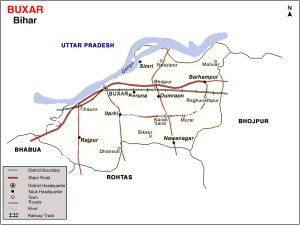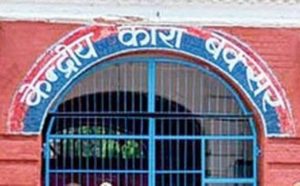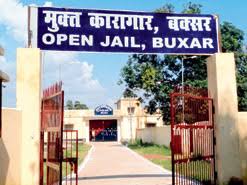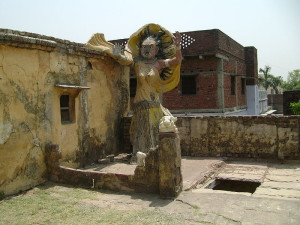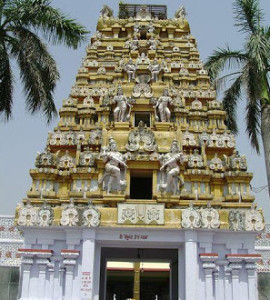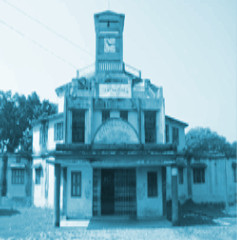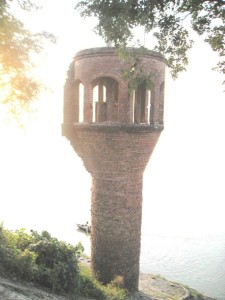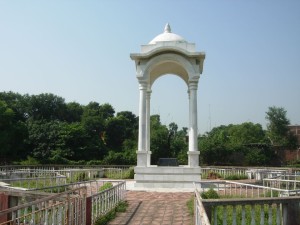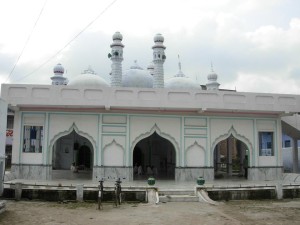BUXAR DISTRICT
Gobindapur:-
During Archaeological
The present district of Buxar consists of areas under Buxar Sadar and Dumraon Sub-Division of the old Bhojpur district and came in existence in the year 1991. Buxar town is the headquarter of the district and also its principal town. The district is bounded on the north by Ballia district of U.P., on the south by Rohtas district, on the west by Ghazipur and Ballia districts of U.P. and on the east by Bhojpur district.
How To Reach
By Air(Airport) :-
Jaiprakash Narayan Airport, Patna is an airport located 127 kilometres from Buxar.
By Rail:-
The Buxar (BXR) railway station, is well connected to most of the major cities in India by the railway network, which lies in between Howrah -Delhi Main Line of East Central Railway in Danapur Division
By Road :-
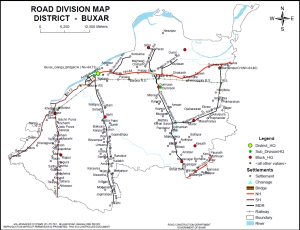 Well connected to other city through National Highway-30,84 SH-13,14,17 Other road-Dumraon-Bikramganj Rd,Itarhi-Dhansoi Rd,Buxar-Itarhi Road,Berhampur Koran Sarai Road,Dhansoi-Dinara Rd,Bhojpur-Simari Rd,Bhojpur-Dumari Rd,Parari-Sonbarsa Rd,Arrah-Buxar Rd.
Well connected to other city through National Highway-30,84 SH-13,14,17 Other road-Dumraon-Bikramganj Rd,Itarhi-Dhansoi Rd,Buxar-Itarhi Road,Berhampur Koran Sarai Road,Dhansoi-Dinara Rd,Bhojpur-Simari Rd,Bhojpur-Dumari Rd,Parari-Sonbarsa Rd,Arrah-Buxar Rd.
Buxar is located 127 kilometres West from Patna.
Popular tourist destinations
BUXAR BLOCK
Buxar Fort(Remnants of Palaces of the king Bhoj or Bikramaditya) :- It is situated on the bank of river Ganga on an artificial mound, where the sone canal coming from Dehri falls into the river. This fort was built by King Rudra Deo, descendant of Raja Bhoj Singh in 1054 AD. Excavations in 1926-27 along the river bank unearthed two seals with inscriptions in the early Brahmi script that date back to the 3rd and 4th century CE, indicating that the mound is quite ancient.
In 1812 CE, Francis Buchanan visited the fort. It only had the southern side and its bastions. He mentioned that the fort had a subterranean passage which housed ancient images. It was known as Patalganga. When Alexander Cunningham visited the fort in 1871-72, he did not find any historical artefacts there. He said that it was “a purely Brahmanical site” and that it had “nothing of archaeological interest.”
The fort is only for the namesake. The entire ground has been taken over by a government guest house. But there are scattered ruins of the old fort that make the visit worthwhile, particularly for those interested in history and heritage. The major attraction of the place is a magnificent huge Peepal Tree (Ficus Religiosa),which must be about 200 year old.
Ram Rekha Ghat :- It is situated on River Ganga in Buxar. According to the legends, Lord Ramchandra and his younger brother Laxman with their teacher Rishi Vishwamitra had crossed the river Ganga here on their way to Janakpur where he later took part in the Sita Swayamvara. So, this place has become an important pilgrimage to the Hindus. To the east of the ghast there is a big Shivala and Rameshwar Temple and to the west there are som thakurbaries. In a room 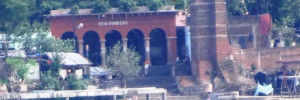 on a tilha close by on the river banks are placed the statues of Sri Ram and Lakshman, while an image of Shri Vishwamitra is placed inside a cell which is approached by descending several steps.On the 18th day of solemn month of Paush, (14th January) of each year, a biggest fair is held here on the Makar Sankranti day. On this day the sun enters the sidereal of zodiac. This fair is also popularly known as Khichri fair. Many People assembles in the town, camp there at several places and bathe in the Ganges at this famous Ramrekha Ghat. The bathing in the river Ganga usually continues for three days.
on a tilha close by on the river banks are placed the statues of Sri Ram and Lakshman, while an image of Shri Vishwamitra is placed inside a cell which is approached by descending several steps.On the 18th day of solemn month of Paush, (14th January) of each year, a biggest fair is held here on the Makar Sankranti day. On this day the sun enters the sidereal of zodiac. This fair is also popularly known as Khichri fair. Many People assembles in the town, camp there at several places and bathe in the Ganges at this famous Ramrekha Ghat. The bathing in the river Ganga usually continues for three days.
Shri Khatu Baba Ashram:-
Shri Nath baba ka Mandir (Sidha-Ashram Nath Ghat) Chritraban:- Chritraban is situated to the west of the town, on the river side. There are a number of ancient Thakurbari.
Shri Adinath Akhara, Shri Nath Ashram, Charitravan popularly known as Shri Nath Baba Mandir was initially constructed by Shri Rama Prasad(Munim Ji) in 1944 (later re-constructed by Shri Nath Baba ji) is situated just 1.5 km from Buxar railway station in the beautiful surroundings of nature at the confluence of the Ganga and Sone canal.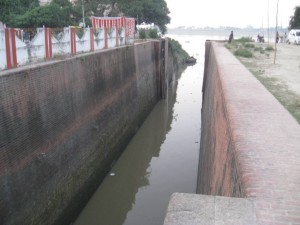
Shri Adinath Akhara hosts Saivite benches such as Someshwar Nath, Rameshwar Nath, Gauri Shankar Mandir, Narmadeshwar Nath, Brahmeshwar Nath and Panchmukhi Shiv Mandir.
A magnificent temple was constructed here and in year 1967, the temple has 22 shivaling as collected from all over the country.
Siddha-Ashram (Rameshwarnath Temple):-The popular belief nowadays is that Viswamitra had his hermitage called Siddha-Ashram here and that the demoness Taraka was killed somewhere in this locality by Shri Ram to protect his sacrifices. It is said that the Siva Linga was established by Sri Ram himself.
Shri Lakshminarayan Mandir:-
Gauri sankar Mandir:-
Shri Chavan Ashram:-
Sahib baba mazar :-
Gauri shankar mandir:-
Gola ghat mandir:-
Tridandi swami aashram:-
Shri Sita Ram Vivah Sthal(Sriman Narayan Raghunandan Sri Ram Ashram):-
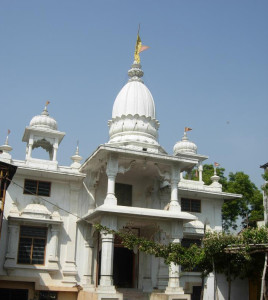 Sri Ram Janki Mandir There’s an Ashram in Naya Bazar locality of Buxar town. The ashram celebrates marriage day ‘the vivah panchami’; the day of marriage of Lord Ram with Sita , every year. Famous as ‘Siya Piya Milan’, the event is attended by a large number of saints and devotees from across the country.
Sri Ram Janki Mandir There’s an Ashram in Naya Bazar locality of Buxar town. The ashram celebrates marriage day ‘the vivah panchami’; the day of marriage of Lord Ram with Sita , every year. Famous as ‘Siya Piya Milan’, the event is attended by a large number of saints and devotees from across the country.
Buxar Central Jail:-
This Jail memorizes the activity of freedom fighters. Besides, it is stander manufacturer and supplier of Tents , Carpets, Tarpaulins, etc to survey department, Bed sheets,Towels and Dusters etc to hospitals and other govt office.
Buxer Open Jail:-
The state’s first open jail, inaugurated by chief minister Nitish Kumar at Buxar on May 23, 2012. It will be the first of its kind in Bihar where convicts would be able to live with their families in an atmosphere conducive to development of their skills and talent so they could make useful contributions to society. This open jail is constructed over 42 acres of land. The Buxar open jail has the capacity to lodge 104 inmates. It offers one-room flat to every prisoner so that they could stay with their family members.The Buxar open jail has also a well-equipped gymnasium for the prisoners.
Statue of Tadka:-
Naulakha Mandir :-
It is located in charitravan. The Navlakha temple, also known as Charitravan Baikunth. Its structure is highly influenced by the temple architecture of South India. According to folklore, Lord Rama (of the epic Ramayana) completed his studies under sage Vishwamitra in Charitravan.
Clock Tower :-
Rani Kuan:-
It is situated at left Bank of river Ganga near M.V. College, Buxar. It is an Ancient well known as Rani Kuwa.
Shaheed Smarak:-
Bari Masjid:-
Sita Ram Upadhyaya Museum :-
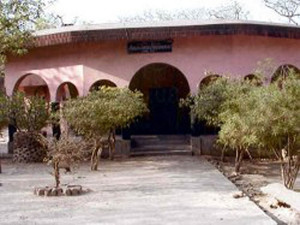 It was in the year 1979 that a museum was opened at Buxar, and some rare stone sculptures and coins adorn its shelves. Hundreds of very impressive terracottas, collected by a local resident Late Sita Ram Upadhyaya, were later donated to the museum. In 1993, the Government of Bihar renamed it as the Sita Ram Upadhyaya Museum after the name of the donor.
It was in the year 1979 that a museum was opened at Buxar, and some rare stone sculptures and coins adorn its shelves. Hundreds of very impressive terracottas, collected by a local resident Late Sita Ram Upadhyaya, were later donated to the museum. In 1993, the Government of Bihar renamed it as the Sita Ram Upadhyaya Museum after the name of the donor.
Timings: 10.30 am to 4.30 pm
Monday closed
Entry free
Vyaghra Sar(Kanwaldah Pokhara):-The Vyaghra Sar also known as Kanwaldah Pokhara is a tourist spot now a days.The word Buxar is said to have been derived from Vyaghra Sar. The tiger face of Rishi Ved Shira, an outcome of the curse of the sage Rishi Durvasa, was restored after bathing in a holy tank which was later named as Vyaghra Sar.
Panch Koshi (Mela)Parikrama (Litti-Chokha Mela):-
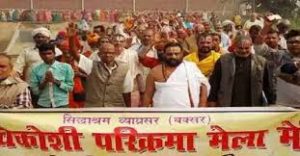 This is a religious area. Many people once in a year during the occasion of Vivah panchami falling in the month of November, take a round of this religious area called panchkoshi parikrama. They perform it in five days by halting in night in five villages surrounding Buxar.
This is a religious area. Many people once in a year during the occasion of Vivah panchami falling in the month of November, take a round of this religious area called panchkoshi parikrama. They perform it in five days by halting in night in five villages surrounding Buxar.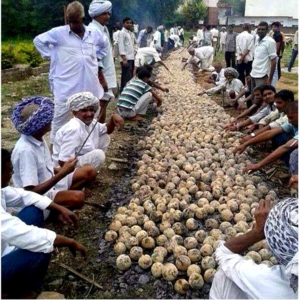 During the visit they cook their own food called litti-bhanta. This is a vegetarian dish which is famous in Bihar, Litti is ball like structure made of wheat powder by filling the black gram roasted powder mixed with salt and spices called sattu. Bhanta( Round Brinjal) roasted in the fire of dung along with potato and tomato finally all are smashed after removing its peel and served with litti which is also roasted in the same fire.
During the visit they cook their own food called litti-bhanta. This is a vegetarian dish which is famous in Bihar, Litti is ball like structure made of wheat powder by filling the black gram roasted powder mixed with salt and spices called sattu. Bhanta( Round Brinjal) roasted in the fire of dung along with potato and tomato finally all are smashed after removing its peel and served with litti which is also roasted in the same fire.
Angrez Kabristan:- It is located in the Kairpurawa locality of Buxar.The Angrez Kabristan (English cemetary) houses the graves of the British soldiers who died during the Battle of Buxar and the 1857 uprising.
Tapoban:- It is said that this is the place where our saints expressed the scripts of Rigveda. Now it inform of a garden.
Devi Ahilya temple ( At Ahirauli village ) :- It is Situated in small village Ahirauli which is about 5 kms north-east of Buxar . According to the local tradition it dates back to the prehistoric ages. As the legend goes Devi Ahilya was the wife of Rishi Gautam. According to the stories of the great epic Ramayana, Devi Ahilya by mistake once identified a person in disguise as her husband. This annoyed Rishi Gautam so much that he turned Devi Ahilya into stones. The temple of Ahirauli, Buxar in Bihar reminds people of the innocence of the Devi. The petrified Devi was after many years rescued by the graceful Lord Ramachandra who saw her while he was passing by. The stone turned to real Devi Ahilya as soon as the Lord touched it.
Boksa:-During Archaeological Explorations performed by KP Jayaswal Research Institute Early medieval Period site have been brought in notice. Nidhua:- During Archaeological Explorations performed by KP Jayaswal Research Institute Medieval Period site have been brought in notice. Dalsagar:- During Archaeological Explorations performed by KP Jayaswal Research Institute Medieval Period site have been brought in notice. Rampur:-During Archaeological Explorations performed by KP Jayaswal Research Institute Medieval Period site have been brought in notice. Mishrawaliya:- During Archaeological Explorations performed by KP Jayaswal Research Institute NBPW phase. site have been brought in notice. Majhariya:- During Archaeological Explorations performed by KP Jayaswal Research Institute Early medieval Period site have been brought in notice. Churamanpur:- During Archaeological Explorations performed by KP Jayaswal Research Institute NBPW phase. site have been brought in notice. Dahiwar:- During Archaeological Explorations performed by KP Jayaswal Research Institute NBPW phase. site have been brought in notice. Chakrahansi(Rahsichak):- During Archaeological Explorations performed by KP Jayaswal Research Institute NBPW phase. site have been brought in notice. Bhatwaliya:- Explorations performed Exploration done by KP Jayaswal Research Institute NBPW phase. site have been brought in notice. Jaso:-During Archaeological Explorations performed by KP Jayaswal Research Institute Late Medieval Period site have been brought in notice. Ramoboria:- During Archaeological Explorations performed by KP Jayaswal Research Institute Early medieval Period site have been brought in notice. Chhotka Nuawan:- During Archaeological Exploration performed by KP Jayaswal Research Institute Medieval Period site have been brought in notice. Jagdispur:- During Archaeological Exploration performed by KP Jayaswal Research Institute Early medieval Period site have been brought in notice. Baruna:- During Archaeological Exploration performed by KP Jayaswal Research Institute Early medieval Period site have been brought in notice. Kamarpur:- During Archaeological Exploration performed by KP Jayaswal Research Institute Early medieval Period site have been brought in notice. Nadaw:- During Archaeological Exploration performed by KP Jayaswal Research Institute Early medieval. Period site have been brought in notice. Bhabhuwar:- During Archaeological Exploration performed by KP Jayaswal Research Institute NBPW phase. Period site have been brought in notice. Saundhila:- During Archaeological Exploration performed by KP Jayaswal Research Institute NBPW phase. Period site have been brought in notice. Madawa Dih:-During Archaeological Exploration performed by KP Jayaswal Research Institute Gupta Period site have been brought in notice. Chhotki Kothia:- During Archaeological Exploration performed by KP Jayaswal Research Institute Gupta Period site have been brought in notice.
Katkauli Maidan (Battle of Buxar):-
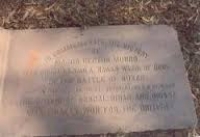
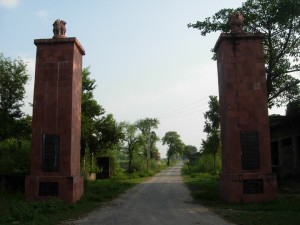 This is where the historic Battle of Buxar was fought in 1764, a signpost in the history of British colonial rule in India. It is situated on the outskirts of the Buxar town about 6 km on the main road to Patna(NH84).
This is where the historic Battle of Buxar was fought in 1764, a signpost in the history of British colonial rule in India. It is situated on the outskirts of the Buxar town about 6 km on the main road to Patna(NH84).
The Muslim Mughal Nawab Mir Qasim of Bengal, made an attempt to recover resource rich province of Bengal from the hands of British. In 1764, he enlisted the support of Mughal Emperor Shah Alam II and Nawab Shuja-ud-Daula, the Nawab of Awadh. On October 23, 1764, Mir Kasim with his army was defeated at the Battle of Buxar by the British Major Hector Munro who led a contingent of 857 European soldiers and 6213 sepoys.
The British built a memorial at the site to commemorate their victory and honour the soldiers who died during the battle.
CHAUSA BLOCK
Chausa Garh(Narbatpur):- Chausa Garh is situated in Chausa at a distance of about 11 Kms East of the district headquarter Buxar.Chausa is situated on the confluence of the rivers Karmanasa and the Ganga which separates it from the neighbouring state U.P. and very well known in the annals of Indian history as the place where in 1539 A.D. Sher Shah defeated the Mughal emperor Humayun. Humayun had to take the ‘Bhisti'(water man) help for crossing the ganges as he was being pursued by Sher Shah. In recognition of the Bhisti’s service Humayun made the water man Emperor for one day.It is also a place of great antiquity.The archaeological and historical importance of this site during the ancient period is evident from a variety of antiquarian remains found on and around Chausa garh, mainly in course of a series of explorations earlier, the most significant being a hoard of 18 Jain bronze images dating right from the Sunga period upto the Gupta period. Chausa is the first site in Gangetic valley which has yielded the first known hoards of bronze in the country.A comparable yield has been recorded earlier in Mohenjo Daro , now in Pakistan.The hoard includes a Dharmachakra showing Dharmachakra supported by two yakshas supported by makaras; a kalpavriksha and sixteen tirthankaras. Among the tirthankaras, those of Lord Rishabha are easily identified by the locks of hair, which are presently preserved in the Patna Museum. A hoard of electrum coins and other ancient coins have had been also found earlier in Chausa. Besides these, fragments of terracotta panels and other objects and a number of stone sculptures also belonging to the ancient period have been found which are of great archaeological importance and are preserved in the Patna Museum and also in the Sita Ram Upadhyaya Buxar Museum.
According to Jayaswal Research Institute Archaeological Explorations this site belongs to NBPW phase period.
Chausa Battle Field :- The Battle (war) of Chausa (June 26,1539) took place between Mughal Emperor Humayun and Sher Shah Suri (Sher Khan). Humayun was defeated in Chausa War by Sher Shah Suri.
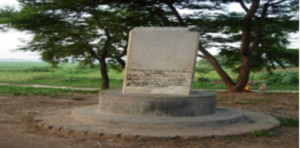 In the battlefield of Chausa, the two forces camped opposite each other, but none of the two warranted an attack for two months. In these two months the Mughal forces suffered the scarcity of food and supply, leading death of cattle and horses. In the desperate situation, Humayun opened the negotiations and arrangement for a treaty was made. As per this treaty, Sher Shah was to retain Bengal and parts of Bihar. In return, he would give recognition to emperor and accept his suzerainty. The men from two armies on the point of this possible settlement started coming on friendly terms and all of a sudden there was a blast. One fine day, on the break of the dawn the Afghans struck the unsuspecting Mughals from all sides. Many of the Mughal soldiers were slain in sleep, few killed mounted on horses. Humayun was saved by a Bhisti, who supported him on his water skin across the river Ganga. Most of the army was drawn in Ganga or captured or killed and the luckless emperor of India came almost alone to Agra in 1539.
In the battlefield of Chausa, the two forces camped opposite each other, but none of the two warranted an attack for two months. In these two months the Mughal forces suffered the scarcity of food and supply, leading death of cattle and horses. In the desperate situation, Humayun opened the negotiations and arrangement for a treaty was made. As per this treaty, Sher Shah was to retain Bengal and parts of Bihar. In return, he would give recognition to emperor and accept his suzerainty. The men from two armies on the point of this possible settlement started coming on friendly terms and all of a sudden there was a blast. One fine day, on the break of the dawn the Afghans struck the unsuspecting Mughals from all sides. Many of the Mughal soldiers were slain in sleep, few killed mounted on horses. Humayun was saved by a Bhisti, who supported him on his water skin across the river Ganga. Most of the army was drawn in Ganga or captured or killed and the luckless emperor of India came almost alone to Agra in 1539.
Sikraul:-During Archaeological Exploration performed by KP Jayaswal Research Institute NBPW phase. Period site have been brought in notice. Banarpur:- During Archaeological Exploration performed by KP Jayaswal Research Institute Early medieval Period site have been brought in notice. Chaubeyjee Ka Dera (Jalilpur):- During Archaeological Exploration performed by KP Jayaswal Research Institute Medieval Period site have been brought in notice. Sarenja:- During Archaeological Exploration performed by KP Jayaswal Research Institute NBPW phase. Period site have been brought in notice. Milki:-During Archaeological Exploration performed by KP Jayaswal Research Institute Medieval Period site have been brought in notice..
DUMRAON BLOCK
Old Fort (Bhojpur Kadim):- It is situated 5 km from Dumraon on Arrah- Buxar road. It was to said to be the seat of Raja Bhoj Singh who founded Bhojpur . After the death of Raja Bhoj Singh his extensive Raj was divided into three part, Dumraon, Buxar and Jagdishpur. The village has some ruins, Brick built walls , a portion of which is known as the ‘Krichichetra’. It is believed that members of the royal family who lived have enjoyed water sports(Jalkira) at this place. It is the former residence of the Dumraon family and said to have been destroyed by Mir Kasim Ali.
Dumraon Raj Palace and Pavilion :- Dumraon town is situated on the main line of the E.R. The town is best known in connection with the Dumraon Raj, to which family it has given its name. A big and well-laid-out flower garden, 1.5 km south-east of the railway station contains a nice tank and the principal palace and pavilion of the Raj both excellent examples of modern Hindu architecture where respectable guests were formerly lodged.The present Dumraon family now mostly lives here. The former residence of the Dumraon family is said to have been destroyed by Mir Kasim Ali.
Dumrajani Mai Tample :- It is about 2 km south of Dumraon.
Temple of Sri Bihariji (Dumraon Swarn Mandir):- It is situated within the Garh compound in Dumraon. It is built about 1840 by Maharaja Jai Prakash Singh. This is the temple where Shehnai maestro Bharat Ratna Ustad Bismillah Khan, a native of Dumraon town, used to play Shehnai along with his father Bachai Miyan,who was the official Shehnai player of the eastate.
Sinhora Sights :-
Jangali Shiv ka Mandir:-
Langatu Mahadeo (Station Road Dumraon):-
Kachneswar Mahadeo ( Kachiniya)
Chilhari:-During Archaeological Exploration done by KP Jayaswal Research Institute Early Medieval Period site have been brought in notice. Niranjanpur:- During Archaeological Exploration done by KP Jayaswal Research Institute NBPW Phase site have been brought in notice. Purana Bhojpur:-During Archaeological Exploration done by KP Jayaswal Research Institute NBPW Phase site have been brought in notice.
Nawratan Garh(Bhojpur Quila or Raja Bhoi Quila):- It is located at Naya Bhojpur, 19 km east of Buxar on NH84. Raja Rudrapratap Narayan Singh built Navratna Garh, also known as Bhojpur Quila or Raja Bhoj Quila in 1633 CE. It is said that there were 52 lanes and 56 doors in the fort. According to folklore, the fort used to shine so bright at night that it was visible from Delhi and that is why the Mughal officer Abdullah Khan demolished it within three years of construction. And so, there are barely any remains of the fort today. According to folklore, Raja Bhoj of Malwa (Madhya Pradesh) conquered the area now known as Bhojpur and settled here. There are ruins in the region believed to be the palaces of Raja Bhoj and his descendants. However, there is no historical evidence to back this claim. When Francis Buchanan visited the site in 1812 CE, he noticed traces of the old channel of the Ganga (which is now more than 20 km north) there. From this, he concluded that Bhojpur was once an extensive town which the river had washed away.
According to Jayaswal Research Institute Archaeological Explorations this site belongs to Early medieval Period.
Rampur Mathia:–During Archaeological Exploration performed by KP Jayaswal Research Institute NBPW phase site have been brought in notice. Gajarawa:-During Archaeological Exploration performed by KP Jayaswal Research Institute Medieval Period site have been brought in notice. Mathila:–During Archaeological Exploration performed by KP Jayaswal Research Institute NBPW phase. site have been brought in notice. Kuran Sarai Dih:–During Archaeological Exploration performed by KP Jayaswal Research Institute Early medieval. Period site have been brought in notice. Basgitiya Dera:-During Archaeological Exploration performed by KP Jayaswal Research Institute Early medieval. Period site have been brought in notice. Sowan:-During Archaeological Exploration performed by KP Jayaswal Research Institute Kushan Period site have been brought in notice. Nuanv:- During Archaeological Exploration performed by KP Jayaswal Research Institute Early medieval. Period site have been brought in notice. Rehiya Garh:- During Archaeological Exploration performed by KP Jayaswal Research Institute NBPW phase. site have been brought in notice. Saraura:- During Archaeological Exploration performed by KP Jayaswal Research Institute Gupta Period site have been brought in notice. Dheka:- During Archaeological Exploration performed by KP Jayaswal Research Institute Gupta Period site have been brought in notice. Nawadera Dih:-During Archaeological Exploration performed by KP Jayaswal Research Institute Early medieval Period site have been brought in notice. Barkibaridih (Manbara):-During Archaeological Exploration performed by KP Jayaswal Research Institute Early medieval Period site have been brought in notice. Lahasar Pokhara:- During Archaeological Exploration performed by KP Jayaswal Research Institute Kushan Period site have been brought in notice. Arianw Garh:- During Archaeological Exploration performed by KP Jayaswal Research Institute NBPW phase site have been brought in notice. Dubhaki:-During Archaeological Exploration performed by KP Jayaswal Research Institute Gupta Period site have been brought in notice. Navratna Garh:-During Archaeological Exploration performed by KP Jayaswal Research Institute Early medieval Period site have been brought in notice. Usmanpur:- During Archaeological Exploration performed by KP Jayaswal Research Institute Late Medieval Period site have been brought in notice.
BARHAMPUR BLOCK
Brahmeneshwar Tample(Brahampur) :-
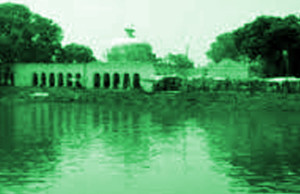 It is situated about 38 km west of Arrah on Arrah-Buxar road. There is a very big temple dedicated to God Shiva with a large tank in front.It is said that the Shiva Linga was established by God Brahma. All the temple face east or north but this one faces west. Sri Tulsidas Ji is said to have visited this place and worshipped in this temple on his way to Shri Jagannath. It is said that an assailant Mahmud Ghazni destroyed this temple and was rebuilt by Raja Man Singh. In this village, large cattle fair is held in the month of Feb-March.
It is situated about 38 km west of Arrah on Arrah-Buxar road. There is a very big temple dedicated to God Shiva with a large tank in front.It is said that the Shiva Linga was established by God Brahma. All the temple face east or north but this one faces west. Sri Tulsidas Ji is said to have visited this place and worshipped in this temple on his way to Shri Jagannath. It is said that an assailant Mahmud Ghazni destroyed this temple and was rebuilt by Raja Man Singh. In this village, large cattle fair is held in the month of Feb-March.
Bararhi:-During Archaeological Exploration performed by KP Jayaswal Research Institute Early medieval Period site have been brought in notice.. Pakarhi:-During Archaeological Exploration performed by KP Jayaswal Research Institute Early medieval Period site have been brought in notice.. Bagen:- During Archaeological Exploration performed by KP Jayaswal Research Institute Early medieval Period site have been brought in notice. Kaithi Garh:-During Archaeological Exploration performed by KP Jayaswal Research Institute Early medieval Period site have been brought in notice. Rajpur:-During Archaeological Exploration performed by KP Jayaswal Research Institute Gupta Period site have been brought in notice. Bhadawar:- During Archaeological Exploration performed by KP Jayaswal Research Institute NBPW phase. site have been brought in notice. Sapahi:-During Archaeological Exploration performed by KP Jayaswal Research Institute Early medieval Period site have been brought in notice. Rahthua:– During Archaeological Exploration performed by KP Jayaswal Research Institute Early medieval Period site have been brought in notice..
NAWANAGAR BLOCK
Rupsagar:–During Archaeological Exploration performed by KP Jayaswal Research Institute Early medieval Period site have been brought in notice. Amirpur Garh:-During Archaeological Exploration performed by KP Jayaswal Research Institute Early medieval Period site have been brought in notice. Turaon Garh:- During Archaeological Exploration performed by KP Jayaswal Research Institute NBPW phase. site have been brought in notice. Nawanagar:- During Archaeological Exploration performed by KP Jayaswal Research Institute Early medieval Period site have been brought in notice. Mahuari:- During Archaeological Exploration performed by KP Jayaswal Research Institute Early medieval Period site have been brought in notice. Sara:– During Archaeological Exploration performed by KP Jayaswal Research Institute Early medieval Period site have been brought in notice. Mariyan:- During Archaeological Exploration performed by KP Jayaswal Research Institute Early medieval Period site have been brought in notice. Sanbarisa Dih:- During Archaeological Exploration performed by KP Jayaswal Research Institute Early medieval Period site have been brought in notice. Waina:– During Archaeological Exploration performed by KP Jayaswal Research Institute Early medieval Period site have been brought in notice. Chawaria:– During Archaeological Exploration performed by KP Jayaswal Research Institute Early medieval Period site have been brought in notice. Giridher Baraon:- During Archaeological Exploration performed by KP Jayaswal Research Institute Early medieval Period site have been brought in notice. Ekil:– During Archaeological Exploration performed by KP Jayaswal Research Institute NBPW phase. site have been brought in notice. Piprarah:- During Archaeological Exploration performed by KP Jayaswal Research Institute Early medieval Period site have been brought in notice. Dhanbakhra:– During Archaeological Exploration performed by KP Jayaswal Research Institute Early medieval Period site have been brought in notice. Parmanpur:- During Archaeological Exploration performed by KP Jayaswal Research Institute Early medieval Period site have been brought in notice. Karsar:- During Archaeological Exploration performed by KP Jayaswal Research Institute Early medieval Period site have been brought in notice. Babuganj Inglish:- During Archaeological Exploration performed by KP Jayaswal Research Institute Early medieval Period site have been brought in notice.
RAJPUR BLOCK
Kharika :- It is situated 6 km south – west of Rajpur. It is noted for the fierce battle between the forces of Babu Kumar Singh and British in year 1857.
Tulsi Sthan(Ragunathpur):-
Patej:- During Archaeological Exploration performed by KP Jayaswal Research Institute Early medieval. Period site have been brought in notice. Babanbandha:- During Archaeological Exploration performed by KP Jayaswal Research Institute Early medieval. Period site have been brought in notice. Bijauli:- During Archaeological Exploration performed by KP Jayaswal Research Institute Early medieval. Period site have been brought in notice. Gauripur:- During Archaeological Exploration performed by KP Jayaswal Research Institute Early medieval. Period site have been brought in notice. Manikpur:- During Archaeological Exploration performed by KP Jayaswal Research Institute Chalcolithic Period site have been brought in notice. Khoraitha:- During Archaeological Exploration performed by KP Jayaswal Research Institute NBPW phase. site have been brought in notice. Sikati:- During Archaeological Exploration performed by KP Jayaswal Research Institute Gupta Period site have been brought in notice. Samahuta:-During Archaeological Exploration performed by KP Jayaswal Research Institute Early medieval. Period site have been brought in notice.
Jagdev Nagar (Hethua):- During Archaeological Exploration performed by KP Jayaswal Research Institute Early medieval. Period site have been brought in notice. Debkali:- During Archaeological Exploration performed by KP Jayaswal Research Institute NBPW phase. site have been brought in notice. Saraon:- During Archaeological Exploration performed by KP Jayaswal Research Institute Early medieval. Period site have been brought in notice. Kishunipur:- During Archaeological Exploration performed by KP Jayaswal Research Institute Early medieval. Period site have been brought in notice. Dhansoi:- During Archaeological Exploration performed by KP Jayaswal Research Institute Early medieval Period site have been brought in notice. Sisaudha:- During Archaeological Exploration performed by KP Jayaswal Research Institute Early medieval. Period site have been brought in notice. Bandagarh (Katharai):- During Archaeological Exploration performed by KP Jayaswal Research Institute NBPW phase. site have been brought in notice. Mangraon:-During Archaeological Exploration performed by KP Jayaswal Research Institute Early medieval. Period site have been brought in notice. Kocharhi:- During Archaeological Exploration performed by KP Jayaswal Research Institute Medieval Period site have been brought in notice. Hethua:- During Archaeological Exploration performed by KP Jayaswal Research Institute NBPW phase. Site have been brought in notice. Bhagwanpur:- During Archaeological Exploration performed by KP Jayaswal Research Institute Medieval Period site have been brought in notice. Sitabpur:– During Archaeological Exploration performed by KP Jayaswal Research Institute NBPW phase. site have been brought in notice. Gussi Dehra:- During Archaeological Exploration performed by KP Jayaswal Research Institute Medieval Period site have been brought in notice. Tiara:- During Archaeological Exploration performed by KP Jayaswal Research Institute Early medieval. Period site have been brought in notice. Kharhana:- During Archaeological Exploration performed by KP Jayaswal Research Institute Medieval Period site have been brought in notice. Rajpur:- During Archaeological Exploration performed by KP Jayaswal Research Institute NBPW phase. site have been brought in notice. Patkhauliya:- During Archaeological Exploration performed by KP Jayaswal Research Institute Early medieval. Period site have been brought in notice. Chacharia:- During Archaeological Exploration performed by KP Jayaswal Research Institute Medieval Period site have been brought in notice. Gogahi:- During Archaeological Exploration performed by KP Jayaswal Research Institute NBPW phase. site have been brought in notice. Gangaura:- During Archaeological Exploration performed by KP Jayaswal Research Institute Early medieval. Period site have been brought in notice. Shahbajpur:- During Archaeological Exploration performed by KP Jayaswal Research Institute Early medieval. Period site have been brought in notice. Chandpur:- During Archaeological Exploration performed by KP Jayaswal Research Institute Medieval Period site have been brought in notice. Bharkhara:- During Archaeological Exploration performed by KP Jayaswal Research Institute Early medieval. Period site have been brought in notice.
KESATH BLOCK
Gobindapur:- During Archaeological Exploration performed by KP Jayaswal Research Institute Early medieval Period site have been brought in notice.. Kesath:- During Archaeological Exploration performed by KP Jayaswal Research Institute NBPW phase. Period site have been brought in notice. Dihra:- During Archaeological Exploration performed by KP Jayaswal Research Institute Early medieval Period site have been brought in notice. Katkinar:- During Archaeological Exploration performed by KP Jayaswal Research Institute Kushan Period site have been brought in notice.
SIMRI BLOCK
Ekwana dih:- During Archaeological Exploration performed by KP Jayaswal Research Institute Gupta Period site have been brought in notice. Paila dih:- During Archaeological Exploration performed by KP Jayaswal Research Institute Early medieval Period site have been brought in notice. Chandpali Bind Dera:- During Archaeological Exploration performed by KP Jayaswal Research Institute Early medieval Period site have been brought in notice. Kathar Khurd:- During Archaeological Exploration performed by KP Jayaswal Research Institute Early medieval Period site have been brought in notice. Gaighat:- During Archaeological Exploration performed by KP Jayaswal Research Institute Gupta Period site have been brought in notice. Pakari:- During Archaeological Exploration performed by KP Jayaswal Research Institute Gupta Period site have been brought in notice. Dhananjaypur:- During Archaeological Exploration performed by KP Jayaswal Research Institute Early medieval Period site have been brought in notice.
ITARHI BLOCK
Basudhar:– During Archaeological Exploration performed by KP Jayaswal Research Institute Early medieval Period site have been brought in notice. Sarasti:- During Archaeological Exploration performed by KP Jayaswal Research Institute NBPW phase. site have been brought in notice. Harpur:- During Archaeological Exploration performed by KP Jayaswal Research Institute Pre NBPW phase. site have been brought in notice. Jamugaon:-During Archaeological Exploration performed by KP Jayaswal Research Institute NBPW phase. site have been brought in notice. Mahadah:- During Archaeological Exploration performed by KP Jayaswal Research Institute NBPW phase. site have been brought in notice. Mahila:- During Archaeological Exploration performed by KP Jayaswal Research Institute NBPW phase. site have been brought in notice. Basantpur:- During Archaeological Exploration performed by KP Jayaswal Research Institute Early medieval Period site have been brought in notice. Raghupur Dera (Unwans):- During Archaeological Exploration performed by KP Jayaswal Research Institute NBPW phase. site have been brought in notice. Parsotimpur:- During Archaeological Exploration performed by KP Jayaswal Research Institute NBPW phase. site have been brought in notice.
Baladeva:- During Archaeological Exploration performed by KP Jayaswal Research Institute Early medieval Period site have been brought in notice. Indaur:- During Archaeological Exploration performed by KP Jayaswal Research Institute Early medieval Period site have been brought in notice. Sidhabandh:- During Archaeological Exploration performed by KP Jayaswal Research Institute Early medieval Period site have been brought in notice. Dewasthapur:- During Archaeological Exploration performed by KP Jayaswal Research Institute NBPW phase. site have been brought in notice. Bhitihara:- During Archaeological Exploration performed by KP Jayaswal Research Institute Early medieval Period site have been brought in notice. Chilbila:- During Archaeological Exploration performed by KP Jayaswal Research Institute NBPW phase. site have been brought in notice. Kukurha:- During Archaeological Exploration performed by KP Jayaswal Research Institute Medieval Period site have been brought in notice. Hakimpur:- During Archaeological Exploration performed by KP Jayaswal Research Institute NBPW phase. site have been brought in notice. Chandudihara:- During Archaeological Exploration performed by KP Jayaswal Research Institute Gupta site have been brought in notice. Barkagaon:- During Archaeological Exploration performed by KP Jayaswal Research Institute Gupta site have been brought in notice. Nihalpur:- During Archaeological Exploration performed by KP Jayaswal Research Institute Gupta site have been brought in notice. Girdharpur:- During Archaeological Exploration performed by KP Jayaswal Research Institute NBPW phase. site have been brought in notice. Gopalpur:- During Archaeological Exploration performed by KP Jayaswal Research Institute Early medieval Period site have been brought in notice. Bhitihara Dih:- During Archaeological Exploration performed by KP Jayaswal Research Institute Early medieval Period site have been brought in notice. Barhana:- During Archaeological Exploration performed by KP Jayaswal Research Institute Gupta site have been brought in notice. Kharhana:- During Archaeological Exploration performed by KP Jayaswal Research Institute Gupta site have been brought in notice. Karmi:- During Archaeological Exploration performed by KP Jayaswal Research Institute NBPW phase. site have been brought in notice. Lohni:- During Archaeological Exploration performed by KP Jayaswal Research Institute Medieval Period site have been brought in notice. Udaipura:- During Archaeological Exploration performed by KP Jayaswal Research Institute Early medieval Period site have been brought in notice. Kusahi Bharat Ka Dih (Kukurha):- During Archaeological Exploration performed by KP Jayaswal Research Institute NBPW phase. site have been brought in notice.
Pitarhi Dih:- During Archaeological Exploration performed by KP Jayaswal Research Institute NBPW phase. site have been brought in notice. Kaithana:- During Archaeological Exploration performed by KP Jayaswal Research Institute Early medieval Period site have been brought in notice. Chilhar:- During Archaeological Exploration performed by KP Jayaswal Research Institute Early medieval Period site have been brought in notice. Kukurha:- During Archaeological Exploration performed by KP Jayaswal Research Institute Medieval Period site have been brought in notice.
CHAUGAIN BLOCK
Thori:- During Archaeological Exploration performed by KP Jayaswal Research Institute Early medieval Period site have been brought in notice. Chaugain:- During Archaeological Exploration performed by KP Jayaswal Research Institute NBPW phase. site have been brought in notice. Baida Garh:- During Archaeological Exploration performed by KP Jayaswal Research Institute NBPW phase. site have been brought in notice. Pandeypur Dih:-During Archaeological Exploration performed by KP Jayaswal Research Institute Early medieval Period site have been brought in notice.
REFERENCE:-
